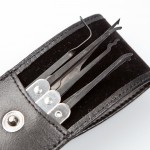Weekly Wrap Volume #43
 Hobbs and His Lock Picks: The Great Lock Controversy of 1851
Hobbs and His Lock Picks: The Great Lock Controversy of 1851
In April 1851, Alfred C. Hobbs boarded the steamship Washington bound for Southampton, England. His official duty was to sell the New York City-based company Day and Newell’s newest product – the parautopic lock – at a trade show – London’s Great Exhibition. But Hobbs had something a bit more nefarious up his sleeve, or rather in the small trunk that accompanied him on the ship. In it sat a large assortment of picks, wrenches, rakes, and other slender tools. You see, Hobbs wasn’t just trying to sell his locks. He was trying to prove that his competitors’ locks were, quite simply, not good enough. He had the tools, skills, and charisma to do just that. Alfred Hobbs was about to launch the Great Lock Controversy of 1851. Of all the locks at the Great Exhibition in July of 1851, the “Detector” was thought of as… (more)
 Why We Call Someone Who is Insane a “Basket Case”
Why We Call Someone Who is Insane a “Basket Case”
At first, “basket case” didn’t mean someone who was crazy. Instead, it referred to someone who had a physical disability. The phrase has its origins in World War I. Funny enough, one of the earliest known documented instances of the phrase was actually in denial that “basket cases” actually existed, as found in a bulletin issued in March of 1919 on behalf of the United States Surgeon General: “The Surgeon General of the Army… denies…that there is any foundation for the stories that have been circulated…of the existence of basket cases in our hospitals.” But just what was the Surgeon General referring to when he said “basket case”? When… (more)
 Why is Toilet Paper Always White?
Why is Toilet Paper Always White?
Toilet paper is an odd thing. Despite the fact that we often rub it against one of the most sensitive parts of our bodies on a daily basis, very little thought is ever given to where it came from or how it’s made. (On that note, it might surprise you to learn that toilet paper wasn’t commonly used in the United States until the early 20th century and even later in many countries.) In the U.S., coloured toilet paper to match one’s bathroom décor was all the rage in the mid-20th century, with the popularity peaking in the 1970s and then gradually waning until today, when, outside of gag-shops, you’d be hard-pressed to find a roll of coloured toilet paper. So why is this the case? There are several reasons, but one of the primary reasons toilet paper is white is the same… (more)
 Glowing in the Dark, The “Radium Girls”
Glowing in the Dark, The “Radium Girls”
On December 21, 1898, Marie and Pierre Curie discovered the radioactive element radium (in the form of radium chloride), extracting it from uraninite. They first removed the uranium from the uraninite sample and then found that the remaining matter was still radioactive, so investigated further. Along with the barium in the remaining substance, they also detected spectral lines that were crimson carmine, which no one had yet documented or, apparently, observed. These spectral lines were being given off by radium chloride, which they managed to separate from the barium. Five days later, they presented their findings to the French Academy of Sciences. Five years after that, they won a Nobel Prize in physics for their discovery, making Marie Curie the first woman to win a Nobel Prize. She went on to win a second Nobel Prize in 1911; this time in chemistry, with the help of André-Louis Debierne. The two successfully managed to isolate… (more)
 Vasili Arkhipov: The Man Who Saved the World
Vasili Arkhipov: The Man Who Saved the World
In 1962, the U.S. and the Soviet Union were on the brink of possible mutual destruction- the world as a whole was facing a possible nuclear winter and all the devastation that would come with it. The Cold War had been escalated to “tepid” and was close to becoming hot with the failure of the Bay of Pigs in 1961 and the ensuing Cuban Missile Crisis. In May 1962, Soviet President Nikita Khrushchev and Cuban President Fidel Castro reached a “secret” agreement that allowed the Soviets to start building missile sites in Cuba, including stocking them with nuclear missiles- 42 of them. It should be noted here that the U.S. at this time had nuclear missiles in Turkey and Italy that could hit Moscow within 16 minutes of being launched. On the flip-side, the Soviets had plenty of nukes pointed at and perfectly capable of destroying the U.S.’ allies throughout Europe. However, the Soviets did not have nearly the capability to destroy targets in the U.S. itself. Certainly they… (more)
Bonus Quick Facts, Myth Debunking Edition:
- Myth: Velcro was invented by NASA for the space program. In fact, Velcro was already commercially available before being used by NASA. It did receive a huge boost in popularity after being used by NASA on parts of astronauts’ space suits as well as used to allow astronauts to store things along the walls of their space craft. Because of this, similar to Tang, it is a common misconception that Velcro was invented by or for NASA.
- Myth: The last period of the “S.O.S” brand was left off due to an error in the trademark submission. In fact, they meant to leave it off because “S.O.S.” could not be trademarked thanks to the SOS distress signal often being written as “S.O.S.”, even though it’s not actually an acronym. By leaving the last period off, it made the name unique and, thus, the U.S. Patent and Trademark office accepted it.
- Myth: TNT and Dynamite are the same thing. In fact, TNT and dynamite are not the same thing at all, contrary to what the Road Runner and Wiley coyote would have you believe. Dynamite doesn’t actually contain TNT, but rather is comprised of an absorbent mixture soaked in nitroglycerin, which is extremely sensitive to shock, unlike TNT; this is then wrapped in paper and voila, dynamite. TNT or trinitrotuluene is a yellow chemical compound that was originally used as a yellow dye, but later was used as an explosive material due to a variety of convenient features it has, such as being very safe to transport.
- Myth: Honeybees don’t sleep. Honeybees do in fact sleep, though there is always significant activity in the hive 24 hours a day, 365 days a year. Research done in 1988 shows that, occasionally, Honeybees will take rest and become relaxed, their body temperature drops, and they become unresponsive. Their sleep is not exactly like human sleep, but it is considered a form of sleep.
- Myth: A cocoon and a chrysalis are the same thing. In fact, the chrysalis is a butterfly pupa, which is a hard skin that appears after the caterpillar’s final shedding of its skin when it’s attached to a leaf via a silk pad spun by the caterpillar. A cocoon is just a constructed silk casing used by moths and certain other types of insects.
- Myth: Popcorn was first introduced outside of the Americas after Columbus made his jaunt across the big blue. In fact, popcorn was made in such places as China, Sumatra, and India long before 1492. However, archeologists do think that popcorn was first popped in Mexico around at least 80,000 years ago.
- Myth: Slaves likely built the pyramids of Giza. In fact, it is no longer thought that the pyramids of Giza were built by slaves. Archeological evidence shows that the worker’s town comprised of whole families, not just men as would have been the case if they were slaves. Further, the people were extremely well taken care of including the highest quality health care available at the time and they were also extremely well fed. These and other such hints from the past, relatively recently discovered, seem to indicate that the laborers were there of their own volition.
Other Interesting Stuff:
 Why Does Stepping On A LEGO Hurt so Much?
Why Does Stepping On A LEGO Hurt so Much?
Right up there with how the gun on the original Duck Hunt game worked, why it hurts so much to step on a Lego brick is one of the questions we’re asked the most, so it’s high time we answered it. As anyone who’s done it knows, stepping on a Lego block is something akin to being shot in the foot by a knife soaked in wasp venom. In truth, this is an inherent danger of allowing a child to exist in your home. While we’ll never know who was the first person to step on a Lego block and curse the day Kirk Kristiansen “borrowed” the idea of Lego bricks from the patented “Kiddicraft Self-Locking Building Bricks,” we can answer the question of why stepping on one of the little buggers hurts so much more than many other common household items. The… (more)
 The Origin of Competitive Eating Contests
The Origin of Competitive Eating Contests
America’s Independence Day is celebrated across the country with fireworks, hot weather, pool parties, and barbecues. For the thousands that gather on Coney Island in America’s largest metropolitan, New York City, July Fourth is commemorated with another annual tradition – the Nathan’s Hot Dog Eating Contest. Beginning in 1916, the Hot Dog Eating Contest has become the “de facto Olympics” for the sport of competitive eating. How and why did competitive eating become so popular? What is the history behind this glutinous sport? The beginnings of competing chowers can be traced back to a Viking parable. While both Thor and Loki are part of the Marvel universe, blessed with several high-grossing movies, they are, of course, actually Nordic gods (and not brothers). Many tales were told of these two’s travels, but the story that applies here is the one where they pay a visit to the court of the giant king Útgard-Loki (meaning “Loki of the Outyards” and a different Loki than Thor’s pal.) As told in the Prose Edda, a compilation of myths from 13th century Iceland, Thor, Loki, and their other travel companion Thialfi… (more)
 Is Eating Your Boogers Good For You?
Is Eating Your Boogers Good For You?
Does physically taking boogers out of your nose, putting them in your mouth and swallowing boost your immune system? The short answer is probably not. You ingest your snot all the time without needing to channel it through your mouth. So if there is a benefit here, you get it without needing to munch your nose nuggets. That said, there are a couple medical professionals willing to comment on the benefits of mining for green candy, particularly touting benefits to one’s immune system. One of the more credible sounding proponents of the habit is Scott Napper, a professor of biochemistry who made waves around the world’s media outlets in 2013 when he half-heartedly proposed to a group of his students that eating one’s boogers allows our bodies to safely develop anti-bodies to the weakened pathogens present in our snot and noses. He also suggested that the reason boogers… (more)
 How “XOXO” Came to Mean “Hugs and Kisses”
How “XOXO” Came to Mean “Hugs and Kisses”
You’ve seen XO as a sign-off representing love, affection, or friendship on letters, cards, emails, chat rooms and text messages. You may have even been torn on whether or not to include both the X and the O, considering one signifies hugs and the other means kisses. Use the incorrect symbol, and one could get the wrong idea! ![]() We can’t be 100% sure why or how XOXO ultimately came to mean “hugs and kisses”, but we do at least have a reasonably good theory to work with on the “X” part. Signing letters with an ‘X’ dates back to the Middle Ages. At this time, many couldn’t read or write, so this was an easy way for someone to sign something and, particularly in legal documents, assert that whatever was said in the document was true. Specifically, the X represented a Christian cross/Christ at this time, so by signing X, you’re essentially saying “In Christ’s name, it’s true / I assert.” “X” first started being used as a substitute for “Christ”… (more)
We can’t be 100% sure why or how XOXO ultimately came to mean “hugs and kisses”, but we do at least have a reasonably good theory to work with on the “X” part. Signing letters with an ‘X’ dates back to the Middle Ages. At this time, many couldn’t read or write, so this was an easy way for someone to sign something and, particularly in legal documents, assert that whatever was said in the document was true. Specifically, the X represented a Christian cross/Christ at this time, so by signing X, you’re essentially saying “In Christ’s name, it’s true / I assert.” “X” first started being used as a substitute for “Christ”… (more)
This Week’s Podcast Episodes:
- Podcast Episode #144: Why Crazy People are Called “Basket Cases”
- Podcast Episode #145: Why When Giving the Time We Reference “O’Clock”
- Podcast Episode #146: Barney Rubble’s Job
- Podcast Episode #147: The Truth About the Cleanliness of Dog Mouths vs. Human Mouths
- Podcast Episode #148: The First Time the Fab Four Played Together
- Podcast Episode #149: The Curious Case of the Man Who Wasn’t Drinking, But was Constantly Drunk
- Podcast Episode #150: The First Lady
Top Posts This Week on TodayIFoundOut’s Facebook Page:
Quote of the Week:
- “Easily lower your monthly bills by moving them from the counter to the floor where you’ve been crying since you opened the mail.” –Jeff Wysaski
| Share the Knowledge! |
|




